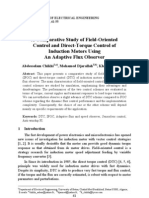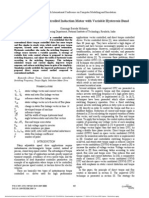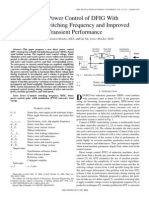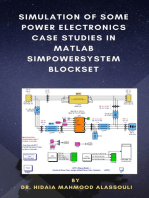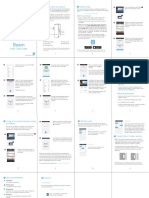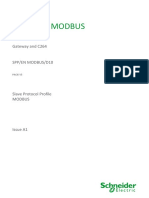Jeas 0408 94
Jeas 0408 94
Uploaded by
Jun Chee LimCopyright:
Available Formats
Jeas 0408 94
Jeas 0408 94
Uploaded by
Jun Chee LimOriginal Title
Copyright
Available Formats
Share this document
Did you find this document useful?
Is this content inappropriate?
Copyright:
Available Formats
Jeas 0408 94
Jeas 0408 94
Uploaded by
Jun Chee LimCopyright:
Available Formats
VOL. 3, NO.
2, APRIL 2008
ISSN 1819-6608
ARPN Journal of Engineering and Applied Sciences
2006-2008 Asian Research Publishing Network (ARPN). All rights reserved.
www.arpnjournals.com
IMPLEMENTATION AND SIMULATION OF DIRECT TORQUE CONTROL SCHEME WITH THE USE OF FPGA CIRCUIT
Sarat Kumar Sahoo1, G. Tulasi Ram Das2 and Vedam Subrahmanyam3
2
Department of Electrical and Electronics Engineering, Dr. M.G.R. University, Chennai, India Department of Electrical and Electronics Engineering, J.N.T.U. College of Engineering, Hyderabad, India 3 Department of Electrical and Electronics Engineering, R.M.K. Engineering College, Chennai, India E-mail: sarata1@rediffmail.com
ABSTRACT This paper presents a simple approach to design and implementation of Direct Torque Control (DTC) of three phase squirrel cage induction motor using Matlab/Simulink and FPGA software. The direct torque control of induction machine is a simple control. To maintain this simple control structure while at the same time improving the performance of the DTC drives two simple new techniques i.e. constant switching frequency and stator flux estimation are proposed. To maintain a constant switching a simple torque control is introduced to replace the three level hysteresis comparators. The magnitude and phase error associated with stator flux estimation based on voltage model is compensated by using simple compensator which is based on steady state operation.
Keywords: FPGA, VHDL, induction motor, methodology, DoPC.
1. INTRODUCTION Induction motors have many advantages when compared to direct current (DC) motors. The well known advantages are simple construction, reliability, ruggedness, and low cost. Nevertheless, DC drives have dominated the field of adjustable speed drives, due to the high dynamic performances [14]. Induction machine control was only possible after the development of powerful switching component and efficient control techniques. For instance, the first control theory was presented in 1971 [15] and implemented ten years later with the advent of microprocessors. Induction motor control methods can be divided into scalar and vector control. In scalar control, which is based on relationships valid in steady state, only magnitude and frequency of voltage, current, and flux linkage space vector are controlled. In vector control, which is based on relations valid for dynamic state, not only magnitude and frequency but also instantaneous position of voltage, current, and flux space vector are controlled. Vector control is general control philosophy that can be implemented in many different ways; the most popular method is field oriented control (FOC). In the mid 1980s, the innovative studies of Depenbrock [19], [20] and of Takahashi and Noguchi [21] which depart from the idea of coordinate transformation and the analogy with dc motor control. These innovators proposed to replace the decoupling control, which meets very well with on-off operation of the inverter semiconductor power devices. This control strategy is commonly referred to as direct torque control (DTC). Allowing for a performance even superior to DC machine drives. The DTC scheme is very simple, in its basic configuration it consists of DTC controller, torque and flux calculator and voltage source inverter. The configuration is much simpler than the Field Oriented Control (FOC) system due to the following features: Absence of frame transformer.
No current control loop, hence, the current is not regulated directly. It does not need pulse width modulator and position encoder, which introduce delays and requires mechanical transducers respectively. Stator flux vector and torque estimation is required. The DTC method was introduced two decades ago, a number of technical papers appear in the literature mainly to improve the performance of DTC of induction machines. The two problems usually associated with DTC drives which are based on hysteresis comparators are: (i) variable switching frequency due to the hysteresis comparators used for the torque and flux comparators and (ii) inaccurate stator flux estimations which can degrade the drive performance. Generally, the stator flux is estimated based on the variation of the two types of estimators, namely the voltage and current models [17]. To take advantage of both type of estimators, some researchers have combined both types of estimators, namely the voltage and current models. However, the use of current model will require a speed sensor or speed estimators which in both cases are undesirable. To maintain a speed sensorless operation, only voltage model has to be used. In voltage model technique, low pass (LP) estimator is normally used in place of a pure integrator to avoid integration drift problem [18]. The LP filter however introduces magnitude and phase errors in the estimated flux. This paper proposed a simple yet effective methods to overcome these two problems. To maintain a constant switching frequency, a simple torque controller is introduced to replace the conventional 3-level hysteresis comparator. The magnitude and phase error associated with stator flux estimation based on voltage model is compensated by using simple compensator which is based on steady state operations. The rest of the paper is organised as follows. Section-II presents the
48
VOL. 3, NO. 2, APRIL 2008
ISSN 1819-6608
ARPN Journal of Engineering and Applied Sciences
2006-2008 Asian Research Publishing Network (ARPN). All rights reserved.
www.arpnjournals.com proposed torque controller and Section-III presents the improved stator flux estimation methods. Section-IV presents the FPGA based design methodology for the complete control. Section-V presents the simulation and experimental results of the proposed methods. Finally, conclusions are given. 2. DTC PRINCIPLES The block diagram of the Direct Self Control (DSC) scheme, proposed by Depenbrock [22], is shown in Figure-1. Based on stator flux components sA, sB and sC, the flux comparators generate the digitized variablesdA ,dB, and dC which correspond to active voltage vectorsfor six-step operation.
The negative slope can be obtained by setting the active voltage V s , n to zero, thus
slope =
Te(n+1) Te( n) t
Te( n)
s,r
3 p Lm jr s . j r 4 Ls Lr
(2)
On the other hand, positive slope is given by the non-zero voltage vectors, thus
slope+ = Te ( n+1) Te ( n ) t = Te ( n )
s ,r
3 p Lm V s jr s . j r 4 Ls Lr (3)
2.1. Proposed torque control The proposed torque controller consists of two triangular waveform generators, two comparators and a PI controller. The two triangular waveforms are 1800 out of phase with each other. The triangular waveforms are referred as upper and lower carriers. The offset values of the DC offsets of upper and lower carriers are set to half of its peak to peak value. The upper dc offset is positive while the lower is negative. The output of the proposed torque controller is similar to that of the three level hysteresis comparator [16], which can be either of three states: -1 , 0 or 1. The value of the instantaneous output of the torque controller designated by q(t) is given by:
Figure-1. Direct Self Control (DSC) scheme. The hysteresis torque controller, on the other hand, generates the digitized signal that determines the zero states duration. In the field-weakening region, where the inverter is in six-step operation under rated output voltage, the torque is not determined by the hysteresis torque controller but by a momentary change of the stator flux amplitude. In a simple case, it can be obtained by means of the PI-flux controller of Figure-1. However, for precise control, more complex calculation is required. A DTC drive based on fixed torque hysteresis band, suffer from a varying rate of change of torque which is simply referred to as torque slope and hence torque controller switching frequency, as a function of motor speed, stator and rotor fluxes, and stator voltage. This in turn results in a varying device switching frequency. Variable switching frequency is undesirable since the switching capability of the inverter is not fully utilized. For fixed torque band, the choice of the bands width is normally based on the worst condition which is limited by the thermal condition of the switching devices, thus operation for other conditions are not optimized. The torque slope is given in equation (1)
Te( n+1) Te( n) t
g 1 1 3 p Lm V s,n jr s ( n) . j rg,n = Te( n) + + s r 2 2 Ls Lr
1 q (t ) = 0 1
for
Tpi Cupper
(4)
for Clower < Tpi < Cupper for Tpi Cupper
The average torque error status q(t) is defined as continuous duty ratio and is denoted by d(t). The average is taken over an interval Ttri, which is the period of the triangular carrier waveform. It is defined by:
d (t ) =
1 T ri
t + T ri
q (t ) d t
(5)
The values of the PI controller parameters are chosen based on the linear analysis of the controller. The linear model is obtained by averaging and linearising the torque equations (2) and (3). It can be shown that the positive and negative torque slope equations are given by (6) and (7) respectively,
dTe+ = ATe + Bv s + K1 e e s d
(6)
dTe = ATe K1r dt
Where,
(7)
(1)
49
VOL. 3, NO. 2, APRIL 2008
ISSN 1819-6608
ARPN Journal of Engineering and Applied Sciences
2006-2008 Asian Research Publishing Network (ARPN). All rights reserved.
www.arpnjournals.com
A = B = K1 = 1
s ,r
3 p Lm 4 Ls Lr
s
operating frequency thus improving the steady state performance of the DTC drive. In other words, the LP filter action is effective at all frequencies except at the operating frequency, that is,
r
s
3 p Lm ( s 4 Ls Lr
Averaging and linearising equations (6) and (7), and with further simplifications, it can be shown that
dTe = ATe + Bv s d + K1 (slip ) s dt
v iR j s' = v iR j + c
for = e
(12)
for e
(8)
Based on equation (8), the transfer function between d and Te can be obtained by setting the slip frequency to zero. It can also be shown that the transfer function between the output of the PI controller, Tpi and the averaged duty ratio d is given by a reciprocal of the peak-peak triangular carrier, Cpp. The values of the PI controllers parameters are chosen based on the following constraints: (i) the absolute slope of equation (5) and (6) cannot exceed the triangular carrier slope. (ii) The crossover frequency of the loop gain (bandwidth) cannot exceed half of the carrier triangular frequency. 2.2. Stator flux estimation Stator flux estimation based on voltage model is carried out by using following equation (9)
The LP filter action is therefore valid or effective for the DC offsets and low frequency components present in the sensed currents or voltages. This avoids the integration drift problem while maintaining good system stability. This is due to the fact that the phase and magnitude errors are compensated at the operating frequency. The stator flux is compensated at the operating frequency for the d and q components by determining the expressions for the actual stator flux in terms of estimated stator flux in the stationary reference frame. Figure-2 shows the relationship of the estimated and actual stator flux with their d and q components in the stationary reference frame, denoted by the direct and quadrature axis, ds and qs.
s = (V is Rs )dt
(9)
To avoid integration drift problem due to the dc off-set or measurement noise, a low-pass filter is normally used in place of the pure integrator in stator flux estimation. With a low-pass filter, sinusoidal steady state form, it can be shown that:
s' =
where
Vs I s Rs je + c
(10)
c is the cut-off frequency of the low-pass filter in ' rad/s and s is the estimated stator based on LP filter.
If
Figure-2. Space vectors of stator current, actual stator flux, and estimated stator flux with rotating and stationary reference frame. The compensated flux is given in (13) and (14) and can be incorporated in the flux estimator block. The compensator can be initiated by the flag manually or based on steady state speed error.
' ' sq = q d
s' = s' '
and s = , then it can be shown
that the relation between the estimated stator flux based on LP filter and pure integrator is given by (11):
s' e ' = s e2 + c2
= ( / 2 ) ta n
1
(11)
c e
c e
(13)
e c
' ' sd = d q
(14)
The core of the proposed improvement is to provide a magnitude and phase compensations for the estimated flux, under steady state condition, only at the
The synchronous speed is e is obtained from the measured terminal variables using (15).
50
VOL. 3, NO. 2, APRIL 2008
ISSN 1819-6608
ARPN Journal of Engineering and Applied Sciences
2006-2008 Asian Research Publishing Network (ARPN). All rights reserved.
www.arpnjournals.com
e =
(V
I s Rs
2 s
) . j
(15)
3. FPGA DESIGN METHODOLOGY The steps in the design procedure for the drive system using the proposed controller are illustrated in the flow diagram in Figure-3. The complete DTC model, including the power circuit and the controller is simulated in Matlab / Simulink. When the controller performs as expected in simulation, a VHDL representation of controller can be generated using a special block of the Xilinx System Generator (SG). SG blocks are like standard Simulink blocks except that they can operate only in discrete-time and fixed point format. The two control blocks are simulated in Matlab / Simulink and then built using SG block. The design methodology uses FPGAs as the target device and parameter driven VHDL style coding to describe the digital circuit. All the modules were designed and tested in the Xilinx Foundation Express. The design flow of the overall coding is compiled and synthesized using the popular synthesis tool Synplify. Before synthesis the target device has to be selected. During synthesis a gate level net list is developed in an Electronic Data Interchange Format (EDIF). A file bearing EDIF net list information is created with various extension names depending on the target type.
The target XC2S100 FPGA of Xilinx family is used here in the design and the relevant EDIF net list file created carries .vqm (Verilog Quartus Map) extension. During synthesis and RTL (Register Transfer Level) corresponding to the design code is developed, which represents an optimized design. The Quartus-II tool compiler creates the .vho (VHDL output file) that contains post routing and post partitioning net list information for timing simulation carried out by ModelSim. The .sof (SRAM Object file) file generated during Placement and Routing is downloaded finally to the FPGA target via JTAG (Joint Test Action Group) port. The XC2S100 FPGA is used as the target. Thus the entire design is strictly based on the FPGA design flow concepts and rendered expected results. The development of each module in terms of architecture is based on standardization principles. These principles are regularity, understandability, and reusability of already designed components. The architecture of stator flux, rotor flux and torque estimator are shown in Figure-4. The resulting RTL model of the estimator architecture presenting the VHDL entity is shown in Fig-5.
Figure-4. Architecture of Stator Flux, Rotor Flux, and Torque Estimators.
Figure-3. Methodology design flow.
51
VOL. 3, NO. 2, APRIL 2008
ISSN 1819-6608
ARPN Journal of Engineering and Applied Sciences
2006-2008 Asian Research Publishing Network (ARPN). All rights reserved.
www.arpnjournals.com
Figure-5. RTL model of the estimator architecture. 4. RESULTS Experimentation was carried out with kW, 2 poles induction motor. The experimental setup consists of Xilinx FPGA device (XC2S100), IGBT based VSI, Induction motor and peripheral devices such as ADC, VSI interface board, DAC and a host PC connected with the FPGA via serial interface. The analog to digital conversion time is equal to 2.4s. The block diagram of the experimental set-up is shown in Figure-6.
(a)
(b) Figure-7. Response for a square wave speed reference for (a) proposed torque controller and (b) a hysteresis-based controller.
Figure-6. Experimental set-up. To look at the dynamic response of the proposed controller, a square wave speed command is applied and the waveforms of the rotor speed, torque and d-axis stator flux is as shown in Figure-7(a). For comparison, the same command is applied to the hysteresis-based torque controller with the results shown in Figure-7(b). From the Figure it can be seen that with the proposed controller, the dynamic torque controller is the same as with the hysteresis based controller, with an added advantage of a reduced torque ripple [23]. The compensation and estimations were donewithin the software with sampling frequency of 55s. The frequency spectrum of the phase currents at rotor speed of 10 rad/sec for the proposed torque controller is shown in Figure-8. The steady state stator flux vector locus for the proposed torque controller is shown in Figure-8(a) and (b) present torque response to a step control from 0 N.m to 4 N.m. It shows that torque response do not present large ripples with the proposed torque controller by comparison to hysteresis based controller.
Figure-8. Experimental result of phase current frequency spectrum for proposed torque controller.
52
VOL. 3, NO. 2, APRIL 2008
ISSN 1819-6608
ARPN Journal of Engineering and Applied Sciences
2006-2008 Asian Research Publishing Network (ARPN). All rights reserved.
www.arpnjournals.com ACKNOWLEDGEMENTS The authors would like to thank the management of Dr. M.G.R. Educational and Research Institute (Chennai, India) for its financial support. REFERENCES [1] Bimal K .Bose. 1997. Power Electronics and Variable Frequency Drives. IEEE Press, New York. [2] M. N. Cirstea, A. Dinu, J. Khor, and M. McCormick. 2002. Neural and Fuzzy Logic Control of Drives and Power Systems. Oxford, U.K.: Elsevier. [3] D. L. Perry. 2004. VHDL. McGraw-Hill, New York. (a) [4] K.C. Chang. 1997. Digital Design and Modeling with VHDL and Synthesis. IEEE Computer Society Press, Los Alamitos, California. [5] P. J. Ashenden. 1995. The Designers Guide to VHDL. San Mateo, CA: Morgan Kaufmann. [6] IEEE Standard VHDL Language Reference Manual. IEEE Std 1076-1993. [7] Power System Blockset for use with Simulink,Users Guide. The MathWorks Inc. 2005. (b) Figure-9. Experimental results obtained with the proposed torque controller: (a) Steady state rotor flux vector locus, (b) torque response to a step control. 5. CONCLUSIONS The new torque controller for constant switching frequency and a compensation scheme to eliminate the phase and magnitude errors for the stator flux estimation under steady state condition is proposed. The obtained results have demonstrated that FPGAs are well suited for implementation of complex motor control and estimation algorithms due to their very high execution speed .The architecture contain a set of building blocks. Each block is geared towards a specific algorithm function. To increase module reutilization, standard and modular design principle is proposed. The modules can be readily to suit new requirements such as modification of communication system, addition of measured variable, and modification of control configuration. In the proposed approach, the design time could be reduced because of the accuracy of the simulation attainable with Simulink and Xilinx System Generator at every operation details of FPGA. Most of the time only one step of debugging is required because the design in Simulink represents an exact model of the actual device. This simple scheme has significantly improved the performance of the DTC drive system while at the same time maintaining the simple control structure of the DTC drive. book. 2006. [Online] available: [8] Xilinx data www.xilinx.com. [9] R.D. Turney, C. Dick, D.B. Parlour and J. Hwang. 2005. Modeling and Implementation of DSP, FPGA Solutions. Xilinx Inc. [10] E. Kiel. 2002 Control electronics in drive systems micro-controller, DSPs, FPGAs, ASICs from stateof-art to future trends. In: Proc. PCIM Conf., CDROM. [11] M. Cirstea. 2005. Electronic systems integrated modeling and optimized digital controller prototyping-A novel (HDL) approach. IEEE Ind. Electron. Soc. Newsl. 52(3): 11-13. [12] F. Ricci and H. Le-Huy. 2002. An FPGA-based rapid prototyping platform for variable-speed drives. In: Proc. IEEE IECON. pp. 1156-1161. [13] E. Monmasson, A.A. Naassani, J.P. Louis. 2001. Extension of the DTC concept. IEEE Trans. On Industrial Electronics. 48(3): 715-717. [14] Leonard W. 1991. 30 Years Space Vectors, 20 Years Field Orientation, 10 Years Digital Signal Processing with Controlled AC-Drives. A Review, EPE Journal. 1: 13-20.
53
VOL. 3, NO. 2, APRIL 2008
ISSN 1819-6608
ARPN Journal of Engineering and Applied Sciences
2006-2008 Asian Research Publishing Network (ARPN). All rights reserved.
www.arpnjournals.com [15] Blaschke F. 1971. A New Method for the Structural Decoupling of A.C. Induction Machines. In: Conf. Rec. IFAC, Dusseldorf, Germany. pp 1-15. [16] I. Takahashi and T. Noguchi. 1986. A newquickresponse and high-efficiency control strategy of an induction motor. IEEE Trans. Ind. Applicat. Vol. IA22. [17] P.L. Jansen and R.D. Lorenz. 1994. A physically insightful approach to the design and accuracy assessment of flux observers for field oriented induction machine drives. IEEE Trans Ind. Appl. 30(1). [18] Jun Hu and Bin Hu. 1998. New integration algorithms for estimating motor flux over a wide speed range. IEEE Trans Power Electronics. 13(5). [19] U. Baader, M. Depenbrock and G. Gierse. 1992. Direct self control (DSC) of inverter-fed-induction machine, A basis for speed control without speed measurement. IEEE Trans. Ind. Applicat. 28: 581588. [20] Direct self-control of the flux and rotary moment of a rotary-field machine. U.S. Patent 4 678 248. July 7, 1987. [21] I. Takahashi and T. Noguchi. 1986. A new quick response and high efficiency control strategy of an induction machine. IEEE Trans. Ind. Applica. 22: 820-827. [22] M. Depenbrock. 1988. Direct self control of inverterfed induction machines. IEEE Trans. Power Electron. 3: 420-429. [23] Jun-Koo Kang and Seung-Ki Sul. 1999. New Direct Torque Control of Induction Motor for Minimum Torque Ripple and Constant Switching Frequency. IEEE Trans. Ind. Application. 35(5): 1076-1082.
54
You might also like
- Búsqueda Del Medio - REHS0970 - Cross-Reference For Electrical Connectors (7553) 2222Document93 pagesBúsqueda Del Medio - REHS0970 - Cross-Reference For Electrical Connectors (7553) 2222Juan Perez100% (1)
- Speed Regulation and Torque Ripple Minimization of Induction Motor by DTC With PI and Fuzzy Logic ControllerDocument6 pagesSpeed Regulation and Torque Ripple Minimization of Induction Motor by DTC With PI and Fuzzy Logic ControllerVijay KumarNo ratings yet
- Finalpaper 135Document6 pagesFinalpaper 135vinaynitw257No ratings yet
- Comparision Between Two Level and Three Level Inverter For Direct Torque Control Induction Motor DriveDocument8 pagesComparision Between Two Level and Three Level Inverter For Direct Torque Control Induction Motor DriveMatanAbutbulNo ratings yet
- Combining The Principles of Variable Structure, Direct Torque Control, and Space Vector Modulation For Induction Motor Fed by Matrix ConverterDocument7 pagesCombining The Principles of Variable Structure, Direct Torque Control, and Space Vector Modulation For Induction Motor Fed by Matrix ConverterGacem AminaNo ratings yet
- Assessment of Direct Torque Control For Induction Motor DrivesDocument18 pagesAssessment of Direct Torque Control For Induction Motor DrivesGutta YaswanthNo ratings yet
- Space Vector Flux Weakening Control of PMSM DriverDocument8 pagesSpace Vector Flux Weakening Control of PMSM DriverOsama AttookNo ratings yet
- Application of Space Vector Modulation in Direct Torque Control of PMSMDocument4 pagesApplication of Space Vector Modulation in Direct Torque Control of PMSMenmnabilNo ratings yet
- Comparison of FOC and DTCDocument6 pagesComparison of FOC and DTCchienbkaNo ratings yet
- A Comparative Study of Field-Oriented Control and Direct-Torque Control of Induction Motors Using An Adaptive Flux ObserverDocument15 pagesA Comparative Study of Field-Oriented Control and Direct-Torque Control of Induction Motors Using An Adaptive Flux ObserverFethi FarhaniNo ratings yet
- New DTC WRKDocument8 pagesNew DTC WRKNAENWI YAABARINo ratings yet
- CMP0193 SynopsisDocument6 pagesCMP0193 Synopsissumiths32No ratings yet
- A Direct Torque Controlled Induction Motor With Variable Hysteresis BandDocument6 pagesA Direct Torque Controlled Induction Motor With Variable Hysteresis BandMuhammad SaadNo ratings yet
- Sliding Controller of Switched Reluctance Motor: Ahmed Tahour and Abdel Ghani AissaouiDocument15 pagesSliding Controller of Switched Reluctance Motor: Ahmed Tahour and Abdel Ghani AissaouihasanmasoudiNo ratings yet
- A54 2 Korzeniewski Improved Algorithms of Direct Torque Control MethodDocument11 pagesA54 2 Korzeniewski Improved Algorithms of Direct Torque Control MethodMohamed Elsaid El ShallNo ratings yet
- Im Cordinate Csi CNTRLDocument11 pagesIm Cordinate Csi CNTRLsandeepbabu28No ratings yet
- Deadlock Avoidance in Model Predictive DTC - Tobias Geyer (IEEE)Document10 pagesDeadlock Avoidance in Model Predictive DTC - Tobias Geyer (IEEE)brulimoliNo ratings yet
- Fuzzy Logic Based Direct Power Control of Induction Motor DriveDocument11 pagesFuzzy Logic Based Direct Power Control of Induction Motor DriveNagulapati KiranNo ratings yet
- 04106023Document9 pages04106023ravivarman_snsNo ratings yet
- High Performance Direct Torque Control of Induction Motor Drives Using Space Vector ModulationDocument9 pagesHigh Performance Direct Torque Control of Induction Motor Drives Using Space Vector ModulationMefisto ElNo ratings yet
- Direct Torque Control of Induction Motor Using Artificial Neural NetworkDocument7 pagesDirect Torque Control of Induction Motor Using Artificial Neural NetworkMohamed SomaiNo ratings yet
- DTC FloueDocument6 pagesDTC FloueAbdesslam LokritiNo ratings yet
- Direct Torque Control For Induction Motor Using Intelligent Artificial Neural Network TechniqueDocument7 pagesDirect Torque Control For Induction Motor Using Intelligent Artificial Neural Network TechniqueInternational Journal of Application or Innovation in Engineering & ManagementNo ratings yet
- Adaptive Bandwidth Approach ON DTC Controlled Induction MotorDocument9 pagesAdaptive Bandwidth Approach ON DTC Controlled Induction MotorijicsjournalNo ratings yet
- JESV5SI0109Document5 pagesJESV5SI0109Kiran YaddanapudiNo ratings yet
- A Direct Torque Control Method For CSC Based PMSG Wind Energy Conversion SystemsDocument7 pagesA Direct Torque Control Method For CSC Based PMSG Wind Energy Conversion SystemsLê Xuân ThăngNo ratings yet
- Comparison of Field Oriented Control and Direct Torque Control For Permanent Magnet Synchronous Motor PMSMDocument6 pagesComparison of Field Oriented Control and Direct Torque Control For Permanent Magnet Synchronous Motor PMSMjp_20_20No ratings yet
- Three-Phase Induction Motor DTC-SVM Scheme With Self-Tuning PI-Type Fuzzy ControllerDocument6 pagesThree-Phase Induction Motor DTC-SVM Scheme With Self-Tuning PI-Type Fuzzy Controllerjorgeluis.unknownman667No ratings yet
- Current Mode Controller Design For Single Phase Grid Connected Inverter Using Proportional Resonant Control StrategyDocument6 pagesCurrent Mode Controller Design For Single Phase Grid Connected Inverter Using Proportional Resonant Control StrategyijeteeditorNo ratings yet
- A Sensorless Robust Vector Control of Induction Motor DrivesDocument6 pagesA Sensorless Robust Vector Control of Induction Motor DrivesLava KumarNo ratings yet
- A High Performance Field-Oriented Control For A Switched Reluctance Motor DriveDocument6 pagesA High Performance Field-Oriented Control For A Switched Reluctance Motor Driveapi-26587237No ratings yet
- Simulation Study of Squirrel Cage Induction Generator Fed by A Back-to-Back Converter and by Using A LCL FilterDocument9 pagesSimulation Study of Squirrel Cage Induction Generator Fed by A Back-to-Back Converter and by Using A LCL FilterRami AlanaziNo ratings yet
- Fuzzy Mras PMSMDocument6 pagesFuzzy Mras PMSMFrancisco Liszt Nunes JuniorNo ratings yet
- Complex Controller For Three-Phase Induction Motor Direct Torque Control PDFDocument7 pagesComplex Controller For Three-Phase Induction Motor Direct Torque Control PDFccprado1No ratings yet
- DC Link Approach To Variable-Speed, Sensorless,: Induction Motor DriveDocument5 pagesDC Link Approach To Variable-Speed, Sensorless,: Induction Motor DrivesamirmansourNo ratings yet
- Direct Torque Control (DTC) of PMSM Using Space Vector Modulated Inverter: A Simulink ApproachDocument4 pagesDirect Torque Control (DTC) of PMSM Using Space Vector Modulated Inverter: A Simulink ApproachKushagra KhamesraNo ratings yet
- Dynamic Performance and Analysis of Direct Torque Control Method Based On DSP For PMSM DrivesDocument5 pagesDynamic Performance and Analysis of Direct Torque Control Method Based On DSP For PMSM DrivesRaspy ReddyNo ratings yet
- A Variable-Speed, Sensorless, Induction Motor Drive Using DC Link MeasurementsDocument6 pagesA Variable-Speed, Sensorless, Induction Motor Drive Using DC Link Measurementsgowtam_raviNo ratings yet
- Investigation and Comparative Study of A New Direct Torque Control Strategy Based On A Well-Balanced Multilevel InverterDocument8 pagesInvestigation and Comparative Study of A New Direct Torque Control Strategy Based On A Well-Balanced Multilevel InverterInternational Journal of Innovative Science and Research TechnologyNo ratings yet
- Speed Regulation An Induction Motor Using Reference Adaptive ControlDocument5 pagesSpeed Regulation An Induction Motor Using Reference Adaptive ControlAtakan OzturKNo ratings yet
- New Sensor LessDocument10 pagesNew Sensor LessAbhishek AgarwalNo ratings yet
- Implementation of Digital Signal Controller TMS320C28027 Based PWM For A Single Phase Bidirectional High Frequency Link Photovoltaic InverterDocument8 pagesImplementation of Digital Signal Controller TMS320C28027 Based PWM For A Single Phase Bidirectional High Frequency Link Photovoltaic InverterIfan Seven SeasNo ratings yet
- Speed Control of BLDC Motor Using DSP: 1 4 1 JNTUH Hyderabad, India 2 JNTUH Hyderabad, IndiaDocument5 pagesSpeed Control of BLDC Motor Using DSP: 1 4 1 JNTUH Hyderabad, India 2 JNTUH Hyderabad, IndiapravnkumarNo ratings yet
- IEEE Power System Paper-Analysis of Power System Linearized Model With STATCOM Based Damping StabilizerDocument7 pagesIEEE Power System Paper-Analysis of Power System Linearized Model With STATCOM Based Damping StabilizerAnoop MathewNo ratings yet
- Study of Direct Torque Controlled 3-Phase SCIM With Two and Three-Level Inverters Using ST-DTC and FR-DTC SchemeDocument5 pagesStudy of Direct Torque Controlled 3-Phase SCIM With Two and Three-Level Inverters Using ST-DTC and FR-DTC SchemeAbo KikiNo ratings yet
- Paper 21Document7 pagesPaper 21Anu AthiraNo ratings yet
- Wanchak Lenwari Milijana OdavicDocument5 pagesWanchak Lenwari Milijana OdavicAndreeaNo ratings yet
- GA For Optimal PI in DC Voltage Regulation of D-STATCOMDocument9 pagesGA For Optimal PI in DC Voltage Regulation of D-STATCOMShipra PandeyNo ratings yet
- Full Predictive Cascaded Speed and Current Control of An Induction MachineDocument9 pagesFull Predictive Cascaded Speed and Current Control of An Induction MachineEVTNo ratings yet
- Buck BoostDocument6 pagesBuck BoostAngel MarianoNo ratings yet
- Comparison of DTC and FOCDocument5 pagesComparison of DTC and FOCJuseverck JuniorNo ratings yet
- LMI Robust Control Design For Boost PWM Converters: C. Olalla R. Leyva A. El Aroudi P. Garce S I. QueinnecDocument11 pagesLMI Robust Control Design For Boost PWM Converters: C. Olalla R. Leyva A. El Aroudi P. Garce S I. QueinnecVinícius BaconNo ratings yet
- A Novel Direct Torque Control of An Induction Motor Drive With A Three-Level InverterDocument7 pagesA Novel Direct Torque Control of An Induction Motor Drive With A Three-Level InverterDipti GanatraNo ratings yet
- Djagarov EEEIC 2012Document6 pagesDjagarov EEEIC 2012jagarov4954No ratings yet
- Field-Weakening Control Algorithm For Interior Permanent Magnet Synchronous Motor Based On Space-Vector Modulation TechniqueDocument9 pagesField-Weakening Control Algorithm For Interior Permanent Magnet Synchronous Motor Based On Space-Vector Modulation TechniqueArpan GayenNo ratings yet
- Simulation of Some Power Electronics Case Studies in Matlab Simpowersystem BlocksetFrom EverandSimulation of Some Power Electronics Case Studies in Matlab Simpowersystem BlocksetNo ratings yet
- Simulation of Some Power Electronics Case Studies in Matlab Simpowersystem BlocksetFrom EverandSimulation of Some Power Electronics Case Studies in Matlab Simpowersystem BlocksetRating: 2 out of 5 stars2/5 (1)
- Simulation of Some Power System, Control System and Power Electronics Case Studies Using Matlab and PowerWorld SimulatorFrom EverandSimulation of Some Power System, Control System and Power Electronics Case Studies Using Matlab and PowerWorld SimulatorNo ratings yet
- Some Power Electronics Case Studies Using Matlab Simpowersystem BlocksetFrom EverandSome Power Electronics Case Studies Using Matlab Simpowersystem BlocksetNo ratings yet
- Power Systems-On-Chip: Practical Aspects of DesignFrom EverandPower Systems-On-Chip: Practical Aspects of DesignBruno AllardNo ratings yet
- (Domine M.W. Leenaerts) Circuit Design For RF Tran (BookFi)Document350 pages(Domine M.W. Leenaerts) Circuit Design For RF Tran (BookFi)Krishna PrasadNo ratings yet
- Hlr9h LST Sub ResultDocument270 pagesHlr9h LST Sub ResultPhillip Ramirez0% (1)
- CHS Module 4 Install Computer Systems and NetworksDocument72 pagesCHS Module 4 Install Computer Systems and NetworksRodel MoralesNo ratings yet
- Manual SA-MAX500 Manual de Servicio PDFDocument133 pagesManual SA-MAX500 Manual de Servicio PDFAbel GaunaNo ratings yet
- SR-ES R10. IOM-IOM3 Migration Via CLI ProcedureDocument24 pagesSR-ES R10. IOM-IOM3 Migration Via CLI Procedureyacsibit marlene Monagas SolorzanoNo ratings yet
- CX Z1900LHDocument43 pagesCX Z1900LHDavid Argote BellidoNo ratings yet
- DSX-8000/DSX-5000: Getting Started GuideDocument12 pagesDSX-8000/DSX-5000: Getting Started GuideDominic MarquezNo ratings yet
- TLE ICT CSS 10 Q2 - Week 1 2Document13 pagesTLE ICT CSS 10 Q2 - Week 1 2mat.bandola01No ratings yet
- 4150 C40-D Installation enDocument2 pages4150 C40-D Installation enRachid EL AOUINANo ratings yet
- 1.3.3 NetworksDocument15 pages1.3.3 Networksahme imtiazNo ratings yet
- Hspice Sa PDFDocument1,024 pagesHspice Sa PDFBharat NarumanchiNo ratings yet
- Control Systems and PLC-sample-question-paper (Msbte-Study-Resources)Document5 pagesControl Systems and PLC-sample-question-paper (Msbte-Study-Resources)shubhampawaskar1313No ratings yet
- Bachelor of Science in Electrical Engineering: Four-Year Curriculum Leading To The Degree ofDocument1 pageBachelor of Science in Electrical Engineering: Four-Year Curriculum Leading To The Degree ofcyrelmark cuarioNo ratings yet
- 001-Storage Basics and Application Environments V1.01Document56 pages001-Storage Basics and Application Environments V1.01Phan AnNo ratings yet
- Ais Tester Brochure PDFDocument2 pagesAis Tester Brochure PDFAZRA comNo ratings yet
- Note For Final ExamDocument47 pagesNote For Final ExamDawit MihiretNo ratings yet
- Quick Start Guide: Getting To Know Your Beam Mobile SetupDocument2 pagesQuick Start Guide: Getting To Know Your Beam Mobile SetupobamaNo ratings yet
- Power Electronics Distribution TransformerDocument52 pagesPower Electronics Distribution TransformerSiva ForeviewNo ratings yet
- 3.2 Lab Install Power SupplyDocument1 page3.2 Lab Install Power SupplyPharaoh ĐoanNo ratings yet
- Pacis SPP Modbus: Gateway and C264Document22 pagesPacis SPP Modbus: Gateway and C264vajiravel407No ratings yet
- GASMET In-Situ Technical Data 28v1 2 29 PDFDocument2 pagesGASMET In-Situ Technical Data 28v1 2 29 PDFASTOLFONo ratings yet
- Stability of Haptic Displays: D. W. Weir and J. E. ColgateDocument39 pagesStability of Haptic Displays: D. W. Weir and J. E. ColgateqqwwaNo ratings yet
- A Brief Review On Multi Level Inverter Methodology Topologies and TechniquesDocument5 pagesA Brief Review On Multi Level Inverter Methodology Topologies and TechniquesMurtaza KaziNo ratings yet
- 76.multi Sensor-Smoke, Fire, Temperature, Gas, Metal and Intruder Based Security Robot Using ZigbeeDocument4 pages76.multi Sensor-Smoke, Fire, Temperature, Gas, Metal and Intruder Based Security Robot Using ZigbeeAnil Kumar0% (2)
- The Cabinet Grounding KitDocument2 pagesThe Cabinet Grounding KitАнтон БехтинNo ratings yet
- 1.cs Lab Manual Original (1,2,4,5,9,10,11,12)Document113 pages1.cs Lab Manual Original (1,2,4,5,9,10,11,12)I AM A PROGRAMMERNo ratings yet
- ECE3073 Computer Systems Practice Questions: PresentationDocument3 pagesECE3073 Computer Systems Practice Questions: PresentationkewancamNo ratings yet
- Computer System ComponentsDocument47 pagesComputer System Componentsசுதாகரன் கோபாலகிருஷ்ணன்No ratings yet
- Antenna Effects - VLSI ConceptsDocument12 pagesAntenna Effects - VLSI ConceptsSumanth Varma100% (1)









